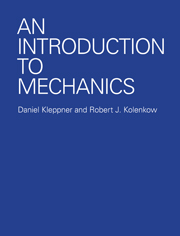Book contents
- Frontmatter
- Contents
- LIST OF EXAMPLES
- PREFACE
- TO THE TEACHER
- AN INTRODUCTION TO MECHANICS
- 1 VECTORS AND VECTORS KINEMATICS—A FEW MATHEMATICAL PRELIMINARIES
- 2 NEWTON'S LAWS—THE FOUNDATIONS OF NEWTONIAN MECHANICS
- 3 MOMENTUM
- 4 WORK AND ENERGY
- 5 SOME MATHEMATICAL ASPECTS OF FORCE AND ENERGY
- 6 ANGULAR MOMENTUM AND FIXED AXIS ROTATION
- 7 RIGID BODY MOTION AND THE CONSERVATION OF ANGULAR MOMENTUM
- 8 NONINERTIAL SYSTEMS AND FICTITIOUS FORCES
- 9 CENTRAL FORCE MOTION
- 10 THE HARMONIC OSCILLATOR
- 11 THE SPECIAL THEORY OF RELATIVITY
- 12 RELATIVISTIC KINEMATICS
- 13 RELATIVISTIC MOMENTUM AND ENERGY
- 14 FOUR VECTORS AND RELATIVISTIC INVARIANCE
- INDEX
5 - SOME MATHEMATICAL ASPECTS OF FORCE AND ENERGY
- Frontmatter
- Contents
- LIST OF EXAMPLES
- PREFACE
- TO THE TEACHER
- AN INTRODUCTION TO MECHANICS
- 1 VECTORS AND VECTORS KINEMATICS—A FEW MATHEMATICAL PRELIMINARIES
- 2 NEWTON'S LAWS—THE FOUNDATIONS OF NEWTONIAN MECHANICS
- 3 MOMENTUM
- 4 WORK AND ENERGY
- 5 SOME MATHEMATICAL ASPECTS OF FORCE AND ENERGY
- 6 ANGULAR MOMENTUM AND FIXED AXIS ROTATION
- 7 RIGID BODY MOTION AND THE CONSERVATION OF ANGULAR MOMENTUM
- 8 NONINERTIAL SYSTEMS AND FICTITIOUS FORCES
- 9 CENTRAL FORCE MOTION
- 10 THE HARMONIC OSCILLATOR
- 11 THE SPECIAL THEORY OF RELATIVITY
- 12 RELATIVISTIC KINEMATICS
- 13 RELATIVISTIC MOMENTUM AND ENERGY
- 14 FOUR VECTORS AND RELATIVISTIC INVARIANCE
- INDEX
Summary
Introduction
The last chapter introduced quite a few new physical concepts—work, potential energy, kinetic energy, the work-energy theorem, conservative and nonconservative forces, and the conservation of energy.
In this chapter there are no new physical ideas; this chapter is on mathematics. We are going to introduce several mathematical techniques which will help express the ideas of the last chapter in a more revealing manner. The rationale for this is partly that mathematical elegance can be a source of pleasure, but chiefly that the results developed here will be useful in other areas of physics, particularly in the study of electricity and magnetism. We shall find how to tell whether or not a force is conservative and how to relate the potential energy to the force.
A word of reassurance: Don't be alarmed if the mathematics looks formidable at first. Once you have a little practice with the new techniques, they will seem quite straightforward. In any case, you will probably see the same techniques presented from a different point of view in your study of calculus.
In this chapter we must deal with functions of several variables, such as a potential energy function which depends on x, y, and z. Our first task is to learn how to take derivatives and find differentials of such functions. If you are already familiar with partial differentiation the next section can be skipped. Otherwise, read on.
- Type
- Chapter
- Information
- An Introduction to Mechanics , pp. 201 - 230Publisher: Cambridge University PressPrint publication year: 2010



